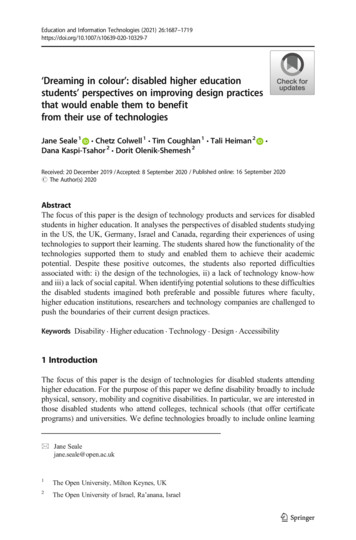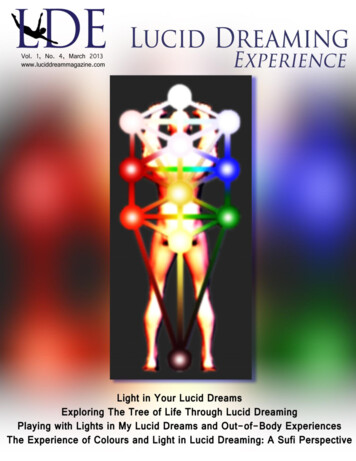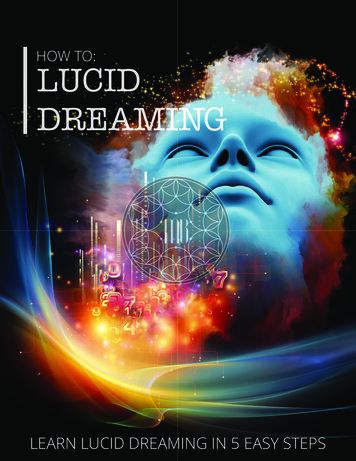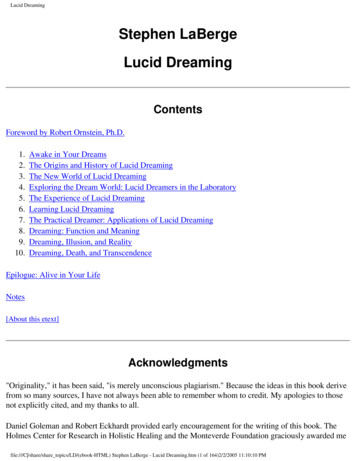
Transcription
Education and Information Technologies (2021) 0329-7‘Dreaming in colour’: disabled higher educationstudents’ perspectives on improving design practicesthat would enable them to benefitfrom their use of technologiesJane Seale 1 & Chetz Colwell 1 & Tim Coughlan 1 & Tali Heiman 2Dana Kaspi-Tsahor 2 & Dorit Olenik-Shemesh 2&Received: 20 December 2019 / Accepted: 8 September 2020 / Published online: 16 September 2020# The Author(s) 2020AbstractThe focus of this paper is the design of technology products and services for disabledstudents in higher education. It analyses the perspectives of disabled students studyingin the US, the UK, Germany, Israel and Canada, regarding their experiences of usingtechnologies to support their learning. The students shared how the functionality of thetechnologies supported them to study and enabled them to achieve their academicpotential. Despite these positive outcomes, the students also reported difficultiesassociated with: i) the design of the technologies, ii) a lack of technology know-howand iii) a lack of social capital. When identifying potential solutions to these difficultiesthe disabled students imagined both preferable and possible futures where faculty,higher education institutions, researchers and technology companies are challenged topush the boundaries of their current design practices.Keywords Disability . Higher education . Technology . Design . Accessibility1 IntroductionThe focus of this paper is the design of technologies for disabled students attendinghigher education. For the purpose of this paper we define disability broadly to includephysical, sensory, mobility and cognitive disabilities. In particular, we are interested inthose disabled students who attend colleges, technical schools (that offer certificateprograms) and universities. We define technologies broadly to include online learning* Jane Sealejane.seale@open.ac.uk1The Open University, Milton Keynes, UK2The Open University of Israel, Ra’anana, Israel
1688Education and Information Technologies (2021) 26:1687–1719(both distance and blended learning); assistive technologies (AT) such as screenreaders and alternative keyboards; general use technologies such as tablets and mobilephones; administrative applications such as registration systems; social and networkingapplications such as Facebook and Twitter as well as specific application technologiessuch as statistical packages. The particular problem the paper will address is thedisadvantage that disabled students in higher education experience, the role technologyplays in mediating (for better or worse) this disadvantage and the implications this hasfor design practice- where design is understood as the design of both products(mainstream and assistive technologies) and services (the support disabled studentsreceive to use technologies) (McCauley 2019).1Over 11% of students enrolled in 2-year and 4-year colleges in Canada and the UnitedStates have a disability (Fichten et al. 2018; Snyder et al. 2016). Similar percentages havebeen reported in other countries. For example, a recent investigation noted that 12% ofundergraduates had a disability in the United Kingdom (Advance 2018). These figures haveincreased from 6% in 1996 in the US and 1.18% in 1994 in the UK (Seale 2014). There arevariations in these figures however, particularly for those some institutions that havetraditionally attracted more disabled students. For example, for the Open University in theUK, figures for 2017/18 suggest that 21% of its student cohort have a declared a disability(HESA 2019). At the Open University of Israel, almost 9% of students asked for learningaccommodation due to their disabilities (The Open University Report 2018). There isevidence to show that disabled students in higher education are less likely than nondisabled students to stay enrolled, earn a higher degree or secure employment(Mamiseishvili and Koch 2012). Some studies have found that disabled students in highereducation take additional time to graduate (Arim 2017; Knight et al. 2018). Whilst otherstudies show that disabled students are more likely to drop out than their non-disabled peers(Rosenbaum 2018) and less likely to graduate (Advance 2018). With regard to employment,studies have shown that disabled graduates are also disadvantaged. For example, Jorgensenet al. (2015) found that of those higher education graduates with disabilities employed orlooking for just 70% were employed a year after graduation, a figure somewhat lower thanthe employment rate of students without disabilities. The same is true in the United Kingdom(Advance 2018). Studies in Britain, Canada and America also reveal that disabled studentswho enrol, but do not complete a higher education program, are less likely to be employedand receive a lower salary than a non-disabled graduate (Advance 2018; Jorgensen et al.2015; Ma et al. 2016).Research in the field, has consistently identified and described a range of benefitsthat technology can afford disabled students in Higher Education which have thepotential to mitigate in some way the disadvantages that they experience. For example,for visually impaired students, technologies such as laptops and e-books are highlightedas they enable the student to receive course material that is traditionally printed onpaper in a digital format, this can then be accessed by technologies such as screenreaders (Bishop and Rhind 2011). Students with learning disabilities (e.g. dyslexia)report benefitting from technologies that can assist in their reading, writing andorganisation of information such as spell-checkers and mind-mapping softwareMcCauley, C (2019) Design community – we need to talk about disabled tdisabled-people/1
Education and Information Technologies (2021) 26:1687–17191689(Roberts and Stodden 2005; Price 2006). Disabled students also appreciate the flexibility that technologies can offer, through the provision of distance learning opportunities (Hammer et al. 2007). When lecturers make materials available on a course website or a course management system or online education platform this allows students tointeract with learning materials outside of the lecture room this can be particularlybeneficial for those students with mobility impairments and mental illness as they canaccess the course from home and still feel part of the learning community (Fichten et al.2020). In the United Kingdom, Disabled Students’ Allowances (UCAS 2018) areavailable to eligible students. The Allowance can fund both technological (mainstreamand specialist technologies) and human support. What makes this particularly valuableis that data show that such allowances have a favourable impact on graduation; 73.9%of disabled students who qualified and received the Disabled Students Allowanceachieved first-class or upper second-class honours compared to 72.5% of those whodid not receive the Allowance (Advance 2018).Despite these potential benefits, there is a significant amount of evidence to indicatethat technology can also have a negative influence on the study experiences of disabledstudents. A commonly reported technology-related barrier to positive experiences is thetechnical inaccessibility of learning platforms (Brandt 2011; Policy Connect 2018),online courses including MOOCs (Roberts et al. 2011; Iniesto et al. 2016; SanchezGordon and Luján-Mora 2018), websites (Kimmons 2017; Seale 2014; Alahmadi andDrew 2017), text-books (McNaught et al. 2018; Fichten et al. 2020), lecture materialsuch as pdfs and PowerPoint slides (Fichten et al. 2009) and social media (Asuncionet al. 2012). Other reported barriers reported include: difficulties obtaining technologies(Reed et al. 2006); unanticipated time demands required learning how to use assistivetechnologies (Hanafin et al. 2007); technology use being contested or valued differentlyby lecturers (Claiborne et al. 2011); being recommended technology based on disabilitylabels rather than need (Stodden and Conway 2003) and lack of availability of adaptedcomputers in campus-based computer laboratories (Fichten et al. (2010a, 2010b). Thephenomenon of technology both mitigating and exacerbating the disadvantage thatdisabled students experience has been labelled a ‘double-edged sword’ (Seale2006:p25). It was first identified in the late 1990’s and has continued into thetwenty-first Century (Fichten et al. 2020).2 Literature reviewResearch in the field has attempted to resolve the conundrum of the ‘double-edgesword’ by seeking to understand in more detail the difficult or negative experiences ofdisabled students in order to identify potential solutions that would lessen or removethese experiences. In this section we will provide an overview of this research andthrough this overview identify gaps in knowledge that the research reported in thispaper will attempt to address.2.1 Disabled students’ experiences of technologyStudies exploring disabled students’ experiences of technology fall into four categories:i) identifying patterns of technology access and use ii) identifying disabled students’
1690Education and Information Technologies (2021) 26:1687–1719perceptions of technology iii) identifying outcomes of technology use and iv) identifying factors that influence technology use.2.1.1 Patterns of technology useStudies exploring patterns of technology access and use reveal that disabled studentscombine both assistive and mainstream technologies to support their studies. Forexample, with regard to assistive technology, Heiman and Olenik-Shemesh (2012)and Heiman et al. (2016) examined the accessibility and the contribution of assistivetechnology to both disabled and non-disabled students in higher education in Israel.Unsurprisingly, they found that disabled students were more familiar with assistivetechnology than non-disabled students. More specifically, they found that students withlearning disabilities frequently utilized assistive technology as an additional study toolduring their studies. 55% of them used Text-to-Speech, 45% used spell checkers, 41%used audiobooks. In a study of 131 French and 1202 English speaking disabledstudents studying at English Language universities and junior community colleges inCanada, Fichten et al. (2010a) used their POSITIVES questionnaire to measure howwell students’ ICT needs were met at home and at university or college. The mostcommon software and hardware that both English and French speaking students usedwere those that helped with writing such as spelling and grammar checkers, predictionsoftware, mind-mapping software and adapted keyboards. While some students appearto really benefit from using assistive technologies, a small number of studies haverevealed that some disabled students choose to abandon their assistive technologies(e.g. Goodman et al. 2002; Roberts and Stodden 2005) Reasons given for abandonmentinclude lack of training on how to use the assistive technology, not having the time tolearn a new piece of technology and the assistive technology not being as functional orhelpful as the student would like (we will return to these issues in the later section onfactors that influence technology use).With regard to mainstream technologies studies have revealed that many disabledstudents (although not all) like using course management systems to print off notesbefore lectures (Gerrard 2007); find using email and instant messaging an effective wayof communicating with peers and tutors (Eden and Heiman 2011); use mobile phonesas a memory aid, spell-checker and calculator (Fichten et al. 2019) and use social mediaboth for study and non-study purposes (Asuncion et al. 2012). There is also evidence tosuggest that disabled students view many mainstream technologies as ‘assistive’ anddon’t necessarily find it helpful to distinguish between mainstream and specialisedassistive technology (Seale et al. 2008). Fichten et al. (2020) argue that disabledstudents are blurring the divisions between mainstream and assistive technologiesand that this gives them access to a vast arrange of technologies from which to choose.2.1.2 Disabled students’ perceptions of technologyStudies have sought to ascertain disabled students’ perceptions regarding the benefits ofusing technology. Some studies reveal largely positive student evaluations of technology. For example, Graves et al. (2011) conducted semi-structured interviews of 11students with specific learning disabilities to investigate whether asynchronous onlineaccess to course recordings was beneficial. The students felt that technology enhanced
Education and Information Technologies (2021) 26:1687–17191691the course concepts and skills, increased organization of course material, increasedconvenience, and improved achievement. More interestingly, they felt that accessingasynchronous online information provided a ‘disability coping mechanism’; it helpedthem self-accommodate the impact of their disability.It is more common however, for studies to show that students neither accept norreject technologies outright; they can see both positive and negative aspects to technology use indicating that they have a more complex relationship with technologiesthan some literature in the field suggests. For example, Unterfrauner and WeiermairMärki (2008) surveyed and interviewed 87 disabled Austrian students. Using a methodinformed by the critical incident technique, participants are asked to identify specificincidents which they had experienced personally and which had made a significantpositive or negative contribution. Deaf and hearing impaired students in the studyreported both positive and negative aspects of technology use. On the positive side,students with hearing impairments said that the use of technology improved theirsituation as students considerably. Online registration for courses or assessments andonline discussion boards to exchange ideas with other students particularly helped thosehaving problems in communicating with others. Information that they would havepreviously had to gather personally at university offices or with the help of anotherperson via telephone, could now be easily retrieved through the Internet or via email,thus improving the autonomy of the person concerned. On the negative side deafstudents complained that videos were rarely captioned. Blind students reported problems accessing information in the VLE and some students with visual impairmentsreported that the process of getting alternative formats very much depended on thegood will of the lecturers.Lewthwaite (2011) explored the experiences of disabled university students in usingsocial networking sites such as Facebook. Lewthwaite was interested in exploring,through internet enabled interviews, how dis/ability and difference were ascribed andnegotiated within social networking sites. In her thesis she presented case studies of 18disabled students from three universities. The case studies revealed that students’experiences were complex and diverse. For some students, using Facebook representedan opportunity to create non-disabled identities, build social capital and mitigateimpairment. Other student experiences were less enabling. As a result Lewthwaiteobserved that for some students, ‘the network’ supported ‘normal’ status, for others, the‘network’ had to be resisted as a form of social domination.2.1.3 Outcomes of technology useA small body of research has sought to quantify the impact that technology has on theacademic success of disabled students whilst in Higher Education, their social wellbeing and their attainment post HE. For example, Hecker et al. (2002) studied how 20higher education students with attention disorders used assistive reading software,Kurzweil, to see if it would affect reading performance. These students used thesoftware for most of a semester to read assignments for an English class and in testingsessions in which comparisons were made between normal, unassisted reading, andreading assisted by the software. Results revealed that students using the software couldread faster, with less stress and fatigue. There is however, no commonly accepteddefinition of academic success as yet and few, if any, validated instruments for
1692Education and Information Technologies (2021) 26:1687–1719measuring academic success. Other possible conceptualisations of academic successcould include performance in academic assessments, retention of lecture information;quality of note-taking and could depend on the kind of technology being used by adisabled student and the context or purpose of its use. Other researchers are starting tolook at psychosocial outcomes related to well-being. For example, Heiman and OlenikShemesh (2012) examined the impact of using technology on the perceived well-being(as measured by a global-hope scale) of students with learning disabilities (e.g.dyslexia). The found a positive correlation between the use of assistive technologiesand web-based courses and well-being. In an additional study focusing this time onstudents with visual impairment, Kaspi-Tsahor et al. (2011) found that use of assistivetechnologies contributed to both students’ academic and socio-emotional satisfaction.Bouck et al. (2012) used data from the National Longitudinal Transition Study-2(NLTS-2) collected in the mid 2000’s to explore the relationship between receipt ofassistive technologies in school and post school outcomes. The NLTS-2 involved fivephases of data collection from disabled students, parents, teachers and other schoolpersonnel regarding the in-school and post-school experiences of a national sample ofdisabled students, aged between 13 and 16 in 2000. The post-hoc analysis of this databy Bouck et al. revealed a complex relationship between receipt of assistive technologies and outcomes. Few students in this study reported receiving assistive technologies in high school (7.85) and fewer still after high school (1.1%). Students with highincidence disabilities (e.g. learning disability, emotional and behavioural disorders)who received assistive technology in school had higher graduation rates, had higherrates of paid jobs, were less likely to be earning less than the minimum wage, and weremore likely to have attended a higher education institution. Yet no student whoreceived assistive technology in school was living independently, and fewer wereworking full-time.2.1.4 Factors that influence technology useIn order to understand why technology is not having a solely positive influence ondisabled students in higher education it is important to understand the factors thatinfluence their use of technology. Studies exploring this influence have identified threemajor factors: whether disabled students know how to use the technology; the supportthey have to use (and learn to use) the technology and the time available to them to use(and learn to use) the technology.Studies that have examined disabled students’ knowledge of technologies havefocused on both confidence levels and skill levels. In a study of 32 dyslexic and nondyslexic students, Woodfine et al. (2008), found evidence of a lack of confidence insome dyslexic students in their study of the use of the Virtual Learning Environment,WebCT. They noted that synchronous communication was such a new challenge thatsome dyslexic students just avoided it and did not even attempt to participate; or theyfelt alienated when they did participate. This could result in dyslexic studentsantagonising their peers and tutors which in turn had the potential to reduce thelikelihood of them receiving help and support. Studies conducted by Seale andcolleagues (Seale et al. 2010, Seale 2013, Seale et al. 2015) however found quitestrong evidence that some disabled students have high levels of confidence in theirability to use technology to support their studies. In a study of 32 students with a range
Education and Information Technologies (2021) 26:1687–17191693of disabilities, Seale et al. (2010) and Seale (2013) found that they were highlyconfident in using technologies and that their confidence levels were linked to howfamiliar or comfortable they felt with the technology. In a survey of 175 disabledstudents, Seale et al. (2015) found that the majority rated their confidence level highly(average of 7.4 out of 10 on confidence scale). In explaining their levels of confidence,the students considered that the nature and value of technologies and having access tohigh quality training influenced their confidence levels.The studies by Seale and colleagues also revealed that disabled students were highlyskilled in their use of technologies. Seale et al. (2010) referred to this ability as ‘digitalagility’. The evidence they presented to support their claim included the fact that themajority of students used instant messaging; participated in discussion forums; usedsocial networking sites such as Facebook and uploaded videos or photos onto theInternet. All the participants used search engines such as Google, accessed onlinelearning materials; used word-processors and spreadsheets and contacted tutors usingemail. Furthermore, all the students customised their computer; particularly toolbars,menu items and the font size on screen to suit their particular learning preferences. Themost common strategies adopted by students to enhance their learning efficiencytended to be related to accessing computers/ information and coping with written work.These strategies therefore involved the use of both specialist assistive technologies (e.g.Inspiration or Dragon Dictate) as well as more generic technologies (e.g. mobile phoneor Google). These strategies were often quite inventive, for example using threedifferent assistive technologies together. In addition, many students demonstrated asophisticated awareness of the pros and cons of using a wide range of technologies andwere able to talk about which particular properties influenced their decisions to usetechnology. The two most frequently mentioned properties were: the efficiency offeredin terms of time management (e.g. organising essays, finding references) and whetheror not the technology supported learning or socialising (Seale 2013). Seale et al. (2015)referred to the skill levels of disabled students as ‘digital cultural capital’. Examples ofthis capital, included: the majority of survey respondents had: experience of searchengines; used an electronic library or portal; used online learning materials they hadfound for themselves; used presentation software such as PowerPoint; contacted tutorsor peers using email; accessed course materials via and online learning environment. Inaddition, the majority of disabled students in the survey were experienced in usingtechnologies for self-management with 83.2% using a computing device to planassignments and 69.9% using a computing device to record lectures. 22 interviewrespondents identified 15 strategies for employing AT to support their learning, withthe most common being recording and transcribing, audible proof-reading and assistance with reading text on screen. They were also highly knowledgeable about theaffordances and constraints of technologies.The literature identifies three sources of support that students either value or findproblematic: support form faculty (e.g. lecturers/tutors); support from student services(e.g. assistive technologists, disabled students officers) and support from peers (e.g.other disabled students, or students on same course, in same university). When facultysupport disabled students to use their technology or ensure that digital course materialis accessible research reveals that students value this highly (Seale 2006). For example,Blankfield and Martin (2002) evaluated a six week access to higher education course,with twelve disabled students and found that the publishing of lecture notes or
1694Education and Information Technologies (2021) 26:1687–1719PowerPoint presentations onto the computer network in advance of lectures wasperceived to be particularly helpful to all of the participants, including those withoutlearning difficulties. Having these documents before the lecture meant that the studentscould make more meaningful notes, which they considered aided their learning andunderstanding. However, the majority of research that evaluates disabled studentsexperiences of faculty support, report dissatisfaction with poor practices such as a lackof awareness of the value of technologies or actively preventing disabled students fromusing technologies. These poor practices do not appear to have lessened over time. Forexample, in 1998, Roessler and Kirk conducted a telephone interview with 40 recentdisabled college graduates regarding the type and quality of technology services theyreceived in college. Although students were satisfied with the auxiliary classroom aidsand technology information they had received, the majority of the participants ratedtheir academic advisors’ knowledge of technology as being inadequate to meet theirneeds. Over twenty years later and Fichten et al., (in press) report that professors oftendislike the presence of students’ personal devices in class and, in some cases, forbidtheir presence. It is perhaps not surprising then, that if students have a choice of who tocall on for support with technology use, faculty are not the first choice. For example, inthe survey by Seale et al. (2015), when asked which sources of support they accessed atschool or college if they needed help using AT, the majority of disabled studentsindicated that their most helpful source of support was learning support staff, followedby privately funded support workers and friends from school or college. When askedwhich sources of support they accessed at school or college if they needed help usinggeneral technologies, survey respondents indicated that their most helpful source ofsupport was friends, followed by learning support staff and teachers/lecturers.Studies reporting the impact of student support services on disabled students’ use oftechnologies reveal a mixture of satisfaction and dissatisfaction. Roberts et al. (2011)used the Disabled Students and Online Learning (SDOL) tool to survey 2366 disabledstudents in five top ranking US colleges in the US. This survey records demographicinformation, documented disabilities and online experiences. Over 45% of studentsindicated that they were very satisfied or satisfied with their institutions ability toaccommodate their disabilities. Over 6% indicated some level of dissatisfaction.Fichten et al. (2010a, 2010b) conducted a survey using the POSITIVES scale of1354 disabled college and university students studying in Canada. The survey focusedon how well their ICT needs were being met. The results were largely positive, withstudents reporting that expertise in adaptive ICTs was readily available on campus.There were concerns however, regarding the availability of adapted computers in theschool’s specialized computer laboratories as well as with institutional computertechnology loan programs. Davies (2007) conducted 5 focus groups of disabled studentfrom across Wales in the UK. Issues identified were: assistive software not keptupdated; appropriate hardware not always available; software not networked; locationof assistive technologies and lack of appropriate support and training. Ari and Inan(2010) surveyed 22 disabled Turkish undergraduate and post graduate students usingan adapted version of the Technology for Disabled students Survey (TSDS). Thissurvey looks at demographic characteristics, technology status, student perception anddisposition towards technology. Results revealed limited school facilities for disabledstudents, accompanied by a severe lack of necessary staff orientation or training inregard to teaching disabled students. Additional facilities, when available, were ill-
Education and Information Technologies (2021) 26:1687–17191695equipped to address student instructional needs. More critically, the schools had failedto provide equal opportunities to those students with special needs while taking courseexams. Despite this, Ari and Inan (2010) consider it promising that almost one-half ofthe students surveyed had the opportunity to use a computer reserved for ‘special needsstudents’.Research studies have found that disabled students both value and benefit fromsupport from their peers. Peer support might come from other disabled students. Forexample, Roer-Strier (2002) reports on efforts at Hebrew University to support thetechnology needs of students with learning disabilities. On the basis of student needsidentified through a first-year evaluation, the school opened a special computer coursefor students with learning disabilities, aimed at utilizing specialist computer technology. The course earned much positive commentary at the end of year feedback session.Students reported that the course improved their personal abilities and gave them asense of partnership with other students with learning disabilities, which reduced theirfeelings of social isolation. Ari and Inan (2010) found that when disabled studentsreceived support and encouragement from their peers, or witnessed the utilization oftechnology by others, their beliefs about what they could do with technology increased.They concluded that informing disabled students about computer technologies and/orallowing them to observe computer use by their peers might lead to an increase in theirbelief in their own ability to utilize technology.Peer support might also emanate from non-disabled students, Seale (2013) reportsthat the disabled students in their study appeared to prefer to seek support for theirtechnology use either from students who were studying the same course or living in thesame halls of residence (i.e.
traditionally attracted more disabled students. For example, for the Open University in the UK, figures for 2017/18 suggest that 21% of its student cohort have a declared a disability (HESA 2019). At the Open University of Israel, almost 9% of students asked for learning accommodation due to their disabilities (The Open University Report 2018 .










